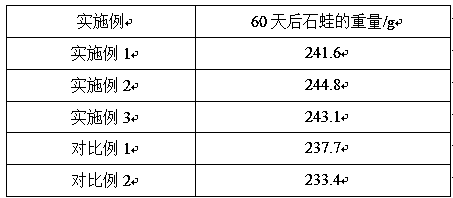Cultivation method for quasipaa spinosa
A breeding method and technology of stone frogs, which are applied in the field of breeding, can solve the problems of not being able to meet the growth needs of tadpoles, unable to meet the growth needs of stone frogs, and slow growth of tadpoles, so as to achieve rich food types, improved water quality, and fast growth. Effect
- Summary
- Abstract
- Description
- Claims
- Application Information
AI Technical Summary
Problems solved by technology
Method used
Image
Examples
Embodiment 1
[0025] 1) Artificial incubation: first take the eggs from the species frog, then hatch the shells at a temperature of 20°C, and transfer them to the tadpole pond after culturing for 20 days;
[0026] 2) Tadpole cultivation: Disinfect the tadpole pond regularly, and feed the tadpole pond until metamorphosis. The components of the feed and their weight percentages are as follows: milk 15%, pumpkin powder 30%, rice 20%, soy milk 20%, starch 12% %, calcium carbonate 2%, Liushenqu powder 1%;
[0027] 3) Breeding of the metamorphic frogs: The metamorphic frogs are fed with small frog food regularly every day until the frog grows into a medium frog with a weight of more than 1 tael. living dragon
[0028] 4) Breeding of the metamorphic frogs: the metamorphic frogs are fed with food of the medium frogs every day until the medium frogs grow into adult frogs weighing more than 2 taels. living dragon
[0029] 5) Breeding of adult frogs after metamorphosis: The adult frogs after metamo...
Embodiment 2
[0032] 1) Artificial hatching: first take the eggs from the species frog, then hatch the shells at a temperature of 23°C, and transfer them to the tadpole pond after 18 days of culture;
[0033] 2) Tadpole cultivation: Regularly disinfect the tadpole pond, and feed the tadpole pond until metamorphosis. The components of the feed and their weight percentages are as follows: milk 20%, pumpkin powder 25%, rice 24%, soybean milk 19%, starch 10% %, calcium carbonate 1.5%, Liushenqu powder 0.5%;
[0034] 3) Breeding of metamorphic frogs: Feed the metamorphic frogs with small frog food regularly every day until the small frogs grow into medium frogs with a weight of more than 1 tael. cm living dragon;
[0035] 4) Breeding of the metamorphic frogs: the metamorphic frogs are fed with food regularly every day until the frogs grow into adult frogs weighing more than 2 taels. cm living dragon;
[0036] 5) Breeding of adult frogs after metamorphosis: The adult frogs after metamorphosis ...
Embodiment 3
[0038] 1) Artificial incubation: first take the eggs from the species frog, then hatch the shells at a temperature of 25°C, and transfer them to the tadpole pond after culturing for 15 days;
[0039] 2) Tadpole cultivation: Regularly disinfect the tadpole pond, and feed the tadpole pond until metamorphosis. The components of the feed and their weight percentages are as follows: milk 17%, pumpkin powder 26%, rice 25%, soybean milk 15%, starch 15% %, calcium carbonate 1%, Liushenqu powder 1%;
[0040] 3) Breeding of the metamorphic frogs: The metamorphic frogs are fed with small frog food regularly every day until the frog grows into a medium frog with a weight of more than 1 tael. the living dragon;
[0041] 4) Breeding of the metamorphic frogs: the metamorphic frogs are fed with food of the medium frog regularly every day until the medium frog grows into an adult frog with a weight of more than 2 taels. living dragon
[0042] 5) Breeding of adult frogs after metamorphosis: ...
PUM
 Login to View More
Login to View More Abstract
Description
Claims
Application Information
 Login to View More
Login to View More - R&D
- Intellectual Property
- Life Sciences
- Materials
- Tech Scout
- Unparalleled Data Quality
- Higher Quality Content
- 60% Fewer Hallucinations
Browse by: Latest US Patents, China's latest patents, Technical Efficacy Thesaurus, Application Domain, Technology Topic, Popular Technical Reports.
© 2025 PatSnap. All rights reserved.Legal|Privacy policy|Modern Slavery Act Transparency Statement|Sitemap|About US| Contact US: help@patsnap.com

